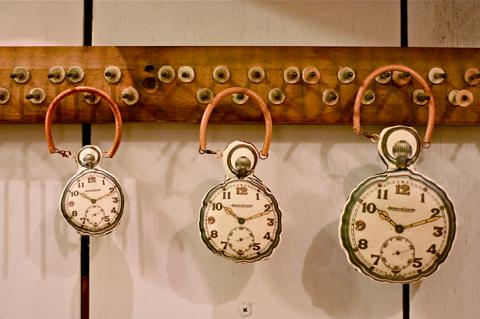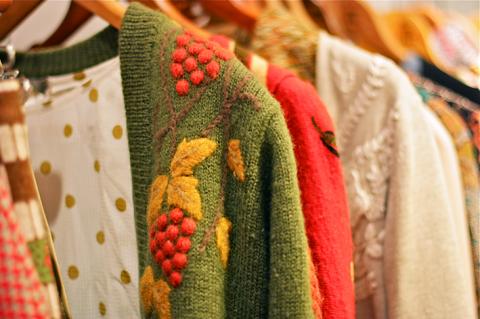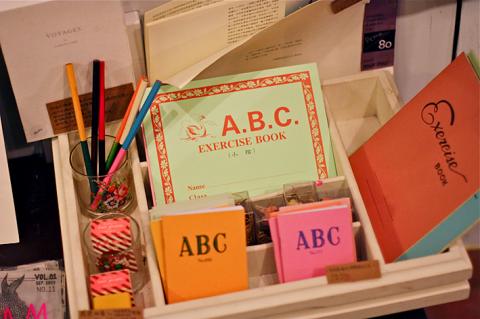Blah Blah Blah is a curiosity shop filled with the weird and wonderful: vintage clothing, handmade accessories and indie zines.
Watches turn out to bracelets with tiny, hand-embroidered clock faces, bags made out of fuzzy fake fur are embellished with portraits of dignified looking cats, and colorful beetles crawl up necklaces.
Blah Blah Blah was founded in 2005 by designer Chen I-shan (陳怡珊) while she was working part time at different boutiques. In her spare time, Chen, whose mother and grandmother taught her how to crochet and sew when she was a girl, stitched bags and clothing for herself. Her friends saw her creations and asked her to make things for them, too.

Photo: Catherine Shu, Taipei Times
Encouraged, Chen began selling her totes at artists’ markets and at stores in Taipei City. She opened her own store near the corner of Zhongxiao East Road and Dunhua South Road three years ago.
Chen says she chose the name Blah Blah Blah because “I’m not very good at using words to express myself.”
“I didn’t go to design school, so I think my style is more free-spirited,” says Chen, who used to sew clothing for her Barbies by hand. “I like combining different materials in new ways and mixing up colors and patterns.”

Photo: Catherine Shu, Taipei Times
Blah Blah Blah’s signature items are reversible totes and handbags sewn from lively printed fabric and made with handles and frames of raw, undyed leather. Some of the cloth used is vintage, like a bright psychedelic print from a Canadian flea market and a modish floral pattern found in an old fabric store Chen stumbled upon while exploring Taitung.
One of Chen’s favorite pastimes is searching for odds and ends to use in her creations. Some pendants are made from vintage shoe buttons, while other necklaces are strung from tiny cube-shaped beads in primary colors imported from Japan.
Another jewelry series features odd-looking pendants made from tree branch slices that are studded with brass nails like the pegs in a pinball machine.

Photo: Catherine Shu, Taipei Times
Blah Blah Blah also carries a colorful assortment of vintage clothing from Japan and Taiwan and a treasure trove of quirky items: ABC practice notebooks from Hong Kong, elaborately beaded bags from the 1950s and 1960s, handmade zines by artist Son (兒子) and colorful rubber toys shaped like letters and numbers that Chen found at the Fuhe Bridge Flea Market (福和橋跳蚤市場).
“I save a lot of little things that I have no idea what to do with at first,” Chen says.
Some of the handicrafts are inspired by children’s toys and books, including Alice in Wonderland. Soft ornaments are sewn from fabric printed with images of clocks and keys and a series of necklaces have pendants made from John Tenniel’s classic illustrations. Sewn from fleece with crocheted heads, “sable” scarves look like cute stuffed animals at first glance, but with leather buttons for eyes and tiny x’s for pupils, the accessories are both whimsical and a little creepy.

Photo: Catherine Shu, Taipei Times
One series of necklaces called Toy Chips was inspired by small plastic pendants called wangzaixian (尪仔仙) that were collected by Taiwanese children in the 1950s and 1960s. Chen cast the original pieces, which she found in a friend’s collection of vintage playthings, in sterling silver and bronze; the shapes include a parrot, a bat and a qilin (麒麟), or Chinese unicorn.
“It’s hard to say exactly where my design inspiration comes from because it’s always different,” Chen says. “I just like to make things that are unexpected.”

In the March 9 edition of the Taipei Times a piece by Ninon Godefroy ran with the headine “The quiet, gentle rhythm of Taiwan.” It started with the line “Taiwan is a small, humble place. There is no Eiffel Tower, no pyramids — no singular attraction that draws the world’s attention.” I laughed out loud at that. This was out of no disrespect for the author or the piece, which made some interesting analogies and good points about how both Din Tai Fung’s and Taiwan Semiconductor Manufacturing Co’s (TSMC, 台積電) meticulous attention to detail and quality are not quite up to

April 21 to April 27 Hsieh Er’s (謝娥) political fortunes were rising fast after she got out of jail and joined the Chinese Nationalist Party (KMT) in December 1945. Not only did she hold key positions in various committees, she was elected the only woman on the Taipei City Council and headed to Nanjing in 1946 as the sole Taiwanese female representative to the National Constituent Assembly. With the support of first lady Soong May-ling (宋美齡), she started the Taipei Women’s Association and Taiwan Provincial Women’s Association, where she

It is one of the more remarkable facts of Taiwan history that it was never occupied or claimed by any of the numerous kingdoms of southern China — Han or otherwise — that lay just across the water from it. None of their brilliant ministers ever discovered that Taiwan was a “core interest” of the state whose annexation was “inevitable.” As Paul Kua notes in an excellent monograph laying out how the Portuguese gave Taiwan the name “Formosa,” the first Europeans to express an interest in occupying Taiwan were the Spanish. Tonio Andrade in his seminal work, How Taiwan Became Chinese,

Mongolian influencer Anudari Daarya looks effortlessly glamorous and carefree in her social media posts — but the classically trained pianist’s road to acceptance as a transgender artist has been anything but easy. She is one of a growing number of Mongolian LGBTQ youth challenging stereotypes and fighting for acceptance through media representation in the socially conservative country. LGBTQ Mongolians often hide their identities from their employers and colleagues for fear of discrimination, with a survey by the non-profit LGBT Centre Mongolia showing that only 20 percent of people felt comfortable coming out at work. Daarya, 25, said she has faced discrimination since she